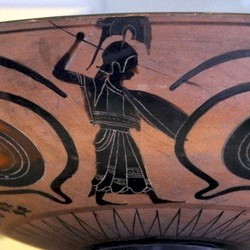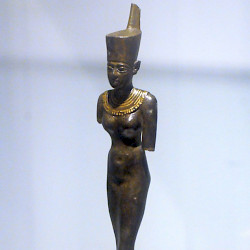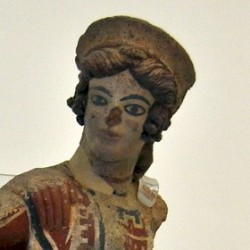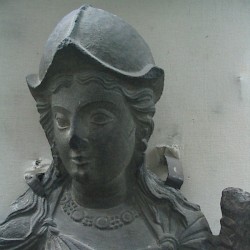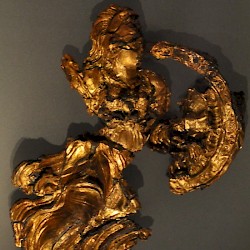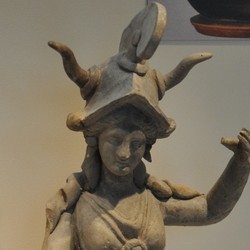Athena
Athena (Greek Ἀθηνᾶ): Greek goddess of wisdom, crafts, and war. The Romans called her Minerva.
Mythology
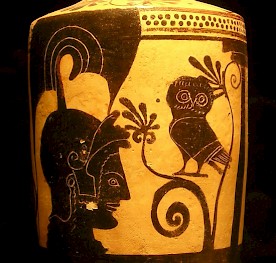
The ancient Greeks knew many stories about the goddess Athena. According to one of these, told by Hesiod, there was a prediction that Zeus' lover Metis would give birth to a deity who was wiser than the supreme god. Afraid that he would lose his power, Zeus swallowed Metis. However, she was already pregnant and the young goddess was born from the head of the supreme god Zeus.
As goddess of warfare, crafts, and wisdom, Athena has a role in many mythological stories, which we know from both written sources (e.g., Homer and Hesiod) and works of art. For instance, several reliefs show Athena as the helper of Prometheus when he was creating the first humans.
An Athenian myth focused on an ancient rivalry between Poseidon and Athena: who was to give his or her name to the new city? Poseidon tried to bribe the citizens by offering them a horse; Athena gave them the olive tree, and won the contest. The city was named after her: Athens.
 Birth of Athena |
 Rome, Sarcophagus with Prometheus and Athena creating the first humans |
 Boeotia, Vase with the judgment of Paris |
 Rome, Forum Transitorium, Relief of Minerva and Arachne |
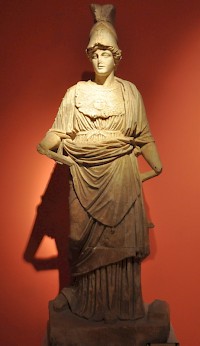
Another famous story is about the judgment of Paris: the Trojan prince Paris has to chose which goddess is the most beautiful. When he chooses Aphrodite, her rivals Athena and Hera become the enemies of Troy, and side with the Greeks during the Trojan War.
Aeschylus tells the story that Orestes, who had killed his mother (who was responsible for the killing of Orestes' father Agamemnon), was judged by a jury, which was undecided about this lawsuit. At that moment, Athena cast the vote in favor of the accused.
A myth that is known from a Roman source, the Metamorphoses by the poet Ovid, is about a weaving competition between Athena and a young woman named Arachne. When the goddess loses the contest, she transforms Arachne into a spider.
In other stories, Athena is the adviser of heroes, like Perseus, Bellerophon, Heracles, Jason and the Argonauts, and of course Odysseus. Athena's attributes are an owl, the olive tree, and a military panoply.
 Sopianae, Relief of Minerva, Perseus, and Medusa |
 Duris, Heracles and Athena |
 Odysseus, Athena, and Nausicaa. |
 Oil lamp. Minerva casts a vote for the release of Orestes |
Cult
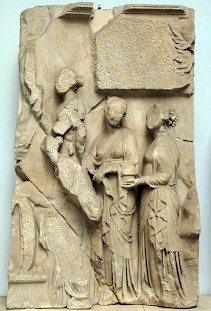
Athena was the patroness of many cities, most famously Athens, where the Parthenon was her main sanctuary and the Panathenaea were the main festival. Her cult was continued well into the early fifth century CE.note She was also the protective deity of Argos, Gortyn, Larisa, Lindos, Mantineia, Priene, Sparta, Tegea, and Troy.
Athena's surnames show her responsibilities. For example:
- as Εργάνη (Ergane, "industrious"), she is the patroness of the arts;
- as Παρθένος (Parthenos), she protects virgins;
- as Πολιάς (Polias), she protects a city (polis);
- as Πρόμαχος (Promachos, "the one fighting in the first line"), she is the leader of the soldiers.
Athena is also called Pallas, which is probably just a girl's name.
 Troy VIII, Coin with the Trojan statue of Athena |
 Delos, Relief of Athena |
 Hildesheim Silver Treasure, Minerva |
 Athena on a coin of Lysimachus |
Other Cults
The Greeks recognized their Athena in various foreign deities, like the goddess Allat of the Arabs and the Neith of the Egyptians of Sais. The most famous example of syncretism was, of course, the Roman goddess Minerva (originally the Etruscan Menrva). Minerva was one of the three gods of the Capitoline Triad, the main cult of the Roman state. (The two other gods were Minerva's parents Jupiter and Juno.) Minerva, the female warrior, was the model of all representations the Dea Roma.
The Statue of Athena
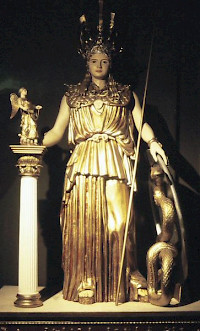
At@@hens had several famous statues of Athena, like the colossal statue of Athena Promachos that dominated the Acropolis, and the reliefs of Athena on the western and eastern pediments of the Parthenon, the main temple of the goddess. The most famous work of art in Athens, however, was the (lost) statue made in the mid-fifth century BCE by the sculptor Phidias, who had been placed in charge of the decoration of the sanctuary by the Athenian politician Pericles. The Greek author Pausanias writes:
The statue is made of ivory and gold. She has a sphinx on the middle of her helmet, and griffins on either side of it. [...] She stands upright in an ankle-length tunic with the head of Medusa in ivory on her breast. She has a Victory of about eight feet high, and a spear in her hand and a shield at her feet, and a snake beside the shield; this snake might be Erichthonius. The plinth of the statue is carved with the birth of Pandora. Hesiod and others say Pandora was the first woman ever born, and the female sex did not exist before her birth.
There are several copies, large and small, of this famous statue, which have been discovered all over the Greek and Roman world.
 Pergamon, Copy of Phidias' Athena |
 Athens, Pnyx, Lenormant Athena |
 Athens, Varvakeion Athena |
 Lepcis, Theater, Statue of Minerva |
Other works of art
Athena/Minerva was one of the most popular deities from the ancient world. There are countless representations, sometimes true works of art, often based on the models from Athens. For example, the Athena on the eastern pediment of the Parthenon (which is now lost) was copied on the famous Altar of Zeus in Pergamon, but also on a casket from Pydna. Other representations were cruder and were used in the private cult of the average Greek or Roman. They have been found everywhere between Britain and the Punjab.

